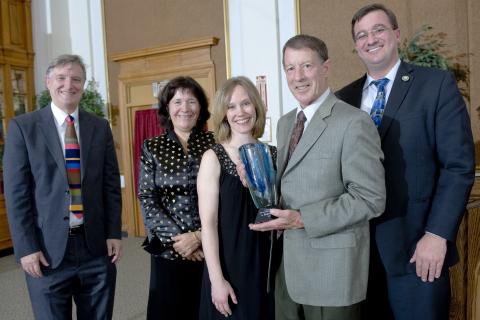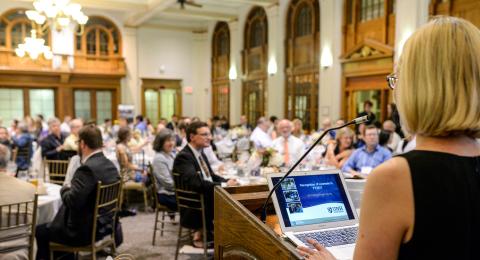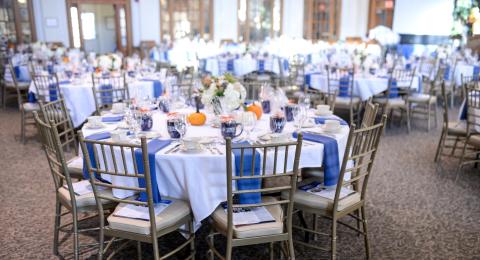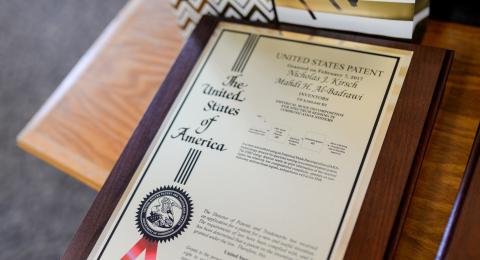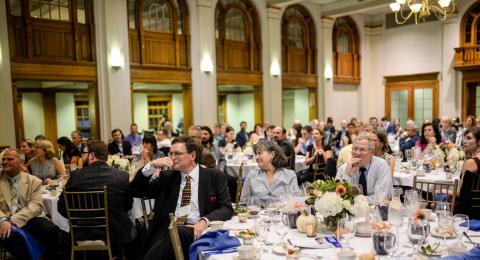Every year, UNHInnovation honors the commercialization of innovative ideas generated through UNH research by awarding the J. Brent Loy Innovator of the Year Award. The award, named for plant geneticist J. Brent Loy who received the university’s inaugural Innovator of the Year award, honors UNH faculty and staff who have demonstrated exemplary innovation commercialization and have successfully translated their research and ideas into social and economic impact.
2022 & 2023 Innovators of the Year
Dr. Christine Shea and Kate Hester Siler (2022) and Jeffrey Halpern (2023)
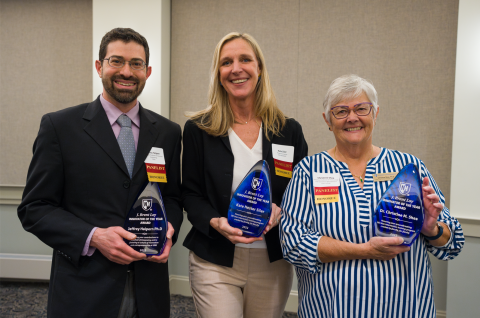
UNHInnovation is proud to recognize the outstanding achievements of Dr. Christine Shea, Kate Hester Siler, and Jeffrey Halpern, the latest recipients of the J. Brent Loy Innovator of the Year Award. Shea and Siler were honored as the 2022 recipients for their work developing IncludeU®, a groundbreaking, research-backed bystander intervention training platform aimed at improving academic workplace climate through education and awareness of unconscious bias. Halpern, awardee for 2023, was recognized for his contributions to biosensing and fostering a culture of research innovation at UNH. The awards were presented on May 2, 2023, during the UNH Research, Economic Engagement and Outreach (REEO) annual celebration.
Shea and Siler were recognized as the 2022 awardees for their significant contributions to UNH's mission of research commercialization through the development of IncludeU®, an online course that uses animated scenarios to provide examples of how faculty can intervene when they see bias occurring. Shea has also published research on leadership, champions of innovation, and bystander intervention in leading journals, and has held various administrative positions at UNH's Paul College of Business and Economics. Siler has managed UNH's ADVANCE Institutional Transformation and ADVANCE Partnership grant programs. Her work is focused on improving workplace climate and reducing bias incidents through programs that support faculty recruitment, retention, and mentoring. She has also served on several university committees and worked on translating scientific concepts into accessible curriculum and professional development offerings in previous positions.
Halpern, 2023 awardee, is an associate professor of chemical engineering in the College of Engineering and Physical Sciences and is a named innovator on five patents, including two issued and two pending, all related to biosensors. His interdisciplinary approach to sensor development involves surface chemistry, materials science, and electrochemistry. He is recognized not only for his work on biosensors, but for developing a culture of innovation at the university and has mentored over 25 undergraduates and summer interns, nine graduate students, and two postdoctoral researchers from seven different academic programs. He was recently honored with the Herb Epstein award for Technical Programing from the American Institute of Chemical Engineers (AIChE) in 2022. Halpern’s work has been supported by various grants, including from the NIH and NSF, and he currently leads a team designing protein sensors in biomanufacturing settings across four states and building a sepsis sensor on a urinary catheter line.
Breaking from the pre-COVID tradition, the Innovator of the Year Awards were presented by Marc Eichenberger, Associate Vice President and Chief Business Development and Innovation Officer, as part of the UNH REEO annual celebration and will be included as a part of this event going forward. President Jim Dean, Provost Wayne Jones, and Senior Vice Provost of Research, Economic Engagement and Outreach Marian McCord offered remarks, commending all of the evening's honorees for their impactful work. In addition to recognizing these awardees, the event also celebrates research faculty and staff who received prestigious non-institutional honors, and in a new addition this year, a panel discussing the impact of innovations created at UNH, moderated by Jenna Matheny, Director of Technology Transfer at UNHInnovation.
“Innovation and research are at the heart of our mission at UNH,” said Eichenberger. “This award represents years of dedication to their work. Tonight, we’re celebrating the success of those research efforts, but also the overall contributions to their field and the impact on not only UNH and the academic community, but the greater public good.”
UNHInnovation provides resources and support for the university’s research and innovation work, including intellectual property protection and commercialization, funding opportunities, and industry partnerships. Congratulations to the awardees for their outstanding achievements and contributions to UNH's mission of research excellence.
2020 & 2021 Innovators of the Year
W. Kelley Thomas and Paul Dean (2020) and Malin Clyde and Haley Anderozzi (2021)
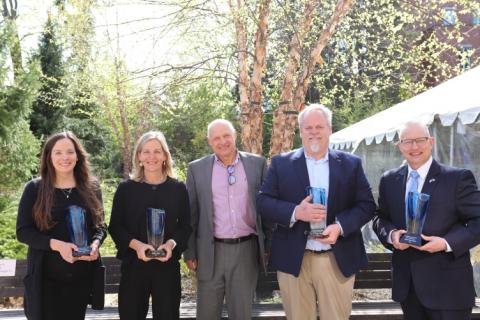
During the COVID pandemic, many of us embraced two new activities: Swabbing our noses to test for the virus and getting outdoors. UNHInnovation’s Innovator of the Year awards recently honored UNH faculty and staff who helped us do both. W. Kelley Thomas, professor and director of the Hubbard Center for Genome Studies, and UNH Police Chief Paul Dean were honored for their contributions to UNH’s COVID response as the 2020 awardees; and UNH Extension’s Malin Clyde and Haley Andreozzi of Nature Groupie, the centralized website for conservation volunteer opportunities, received the honor for 2021.
“The J. Brent Loy Innovator of the Year Award honors UNH faculty or staff who have demonstrated exemplary innovation and successfully translated their ideas into social and economic impact,” says Marc Eichenberger, interim managing director of UNHInnovation. “I can’t think of better examples, especially during these past two years, than UNH’s extraordinary COVID testing program and Nature Groupie.”
Thomas, who is a professor of molecular, cellular and biomedical studies and the COVID lab’s scientific director, played an integral role in designing and launching UNH’s state-of-the-art testing lab in the absence of established infrastructure such as a medical or veterinary school or even a CLIA (Clinical Laboratory Improvement Amendments) lab already on campus. In spring of 2021, under his leadership, the university started genomic sequencing of the SARS-CoV-2 virus, helping prepare for future variant outbreaks.
Dean serves as co-chair of UNH’s Testing and Tracing Team, the task force responsible for launching the lab, and as co-director of the COVID Incident Response Team. He was instrumental in developing the campus testing and tracing strategy, including the innovative self-swabbing protocols and collection logistics.
“Paul and Kelley’s innovation, ingenuity and commitment to the health and safety of the UNH community is inspirational and they are both incredibly deserving of this honor,” says Marian McCord, senior vice provost for research, economic engagement and outreach. “The university is grateful for their expertise and leadership.”
UNH Extension’s Malin Clyde, community volunteer state specialist, and Haley Andreozzi, wildlife conservation state specialist, are the 2021 Innovators of the Year as the driving force behind Nature Groupie, one of several successful mission-driven not-for-profit UNH spinouts.

Nature Groupie, which began in 2013 as a collaboration between UNH Extension and The Stewardship Network in the Great Lakes region, links outdoor enthusiasts with volunteer opportunities at places they love by sharing events that help forests, coastal ecosystems, communities and wildlife. Since that time, more than 5,000 volunteers have connected with 200-plus environmental groups through naturegroupie.org to clean rivers, restore wildlife habitats, maintain trails, plant trees and do environmental research in New England.
A true spinout inspired by market need, Nature Groupie leveraged resources of UNHInnovation to participate in its I-Corps training and pursue trademarking. A Kickstarter campaign raised initial funding for the launch of Nature Groupie, and online sales of apparel branded with their playful, energetic logo help sustain the business.
Established in 2011, UNHInnovation’s Innovator of the Year award is named after the late J. Brent Loy, plant geneticist, inaugural recipient of the award and by far UNH’s most prolific innovator. He developed more than 80 new varieties of squash, pumpkins, gourds and melons during his career, representing the longest squash and pumpkin breeding program in North America. His seed varieties, sold in seed catalogs throughout New England and the world, have created more revenue for UNH than any other faculty-generated intellectual asset.
Written By: Beth Potier | Communications and Public Affairs
2019 Innovators of the Year

2019’s J. Brent Loy Innovator of the Year Award recipients are Jennifer (Jenn) Andrews and Allison (Alley) Leach, Ph.D. for their roles in developing and commercializing SIMAP (Sustainability Indicator Management and Analysis Platform). SIMAP is a comprehensive, valuable online tool that colleges and universities can use to measure, calculate, and report carbon and nitrogen footprints. The mission of SIMAP is to help campuses track their footprints so they can meet their sustainability goals as effectively and efficiently as possible. There are currently over 500 institutions that are using SIMAP to calculate, track, and reduce their negative impact on the environment.
Jenn and Alley recently participated in the UNH I-Corps program, which helped them position SIMAP as an innovation that can also drive student and community engagement in sustainability awareness on campuses. Using their data from I-Corps, they are exploring new business models that will enable greater adoption of SIMAP and new features to help drive lower-emissions on campuses and create a financially sustainable future for SIMAP as a leader in carbon and nitrogen tracking and analysis.
Jenn is a sustainability project director at the UNH Sustainability Institute (UNHSI). She comes to UNHSI from Clean Air-Cool Planet, where she worked for 13 years promoting practical climate solutions for colleges and universities as well as municipalities and businesses. During her tenure there, she helped to launch, oversee, and continually develop the Campus Carbon Calculator, which is now the carbon calculator component of SIMAP. She holds a B.A. in English and an M.A. in Mental Health, both from UNH.
Alley is a postdoctoral researcher with the UNHSI. She is a developer of the nitrogen footprint approach, and she led the integration of the nitrogen footprint calculator into SIMAP. She is also a co-lead of the Nitrogen Footprint Tool Network, a group of campuses that pilot tested the original campus nitrogen footprint model and continues to lead new development and research. She holds a B.S. and M.S. in Environmental Sciences from the University of Virginia and a Ph.D. in Natural Resources and Environmental Studies from UNH.
2018 Innovator of the Year
INTACT first started as a simple home-grown software solution for the purpose of testing networking equipment while supporting the IOL's dual mission of educating students and improving the data communications industry. It has since grown to become the largest licensed product at UNH that is used worldwide.
INTACT has helped the global Internet Community ensure a successful deployment of the next generation of internet protocols (namely IPv6) for supporting the growing Internet. Over the past ten years, the US Government set a requirement of only purchasing IPv6 enabled IT equipment and with the IOL's thought leadership and INTACT software the IOL was ready to support the requirements. If you use the internet then you have benefited from INTACT!
Timothy's leadership was critical, especially in recognizing the need for rapid testing by developers in industry. Tim has spent his career at UNH implementing new strategies to meet the IOL's mission and paving the way for newer innovations. He was essential in taking INTACT as a home-grown solution to a fully viable commercialized product. Without his drive and expertise, companies worldwide would not be able to deploy their products with high confidence. Tim is also providing UNH students experiential learning whereby they improve the software to meet customer requests. These distinctive accomplishments of Timothy Winters reflect credit upon himself and the InterOperability Lab.
2017 Innovator of the Year
Brian Calder, Ph.D
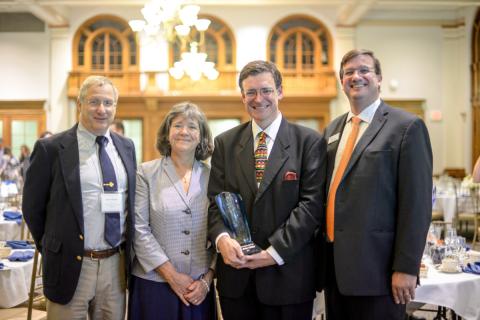
Brian joined UNH in 2000 as a research scientist in the Center for Coastal and Ocean Mapping and the NOAA-UNH Joint Hydrographic Center (CCOM/JHC). He earned his masters and doctoral degrees from Heriot-Watt University in Edinburgh, Scotland, demonstrating his expertise in computing and electrical engineering.
Brian is currently a Research Associate Professor in Ocean Engineering and the Associate Director of CCOM. His research interests include methods for error modeling, propagation and visualization, and adaptive sonar backscatter modeling.
Brian’s research has led to the development of numerous software innovations, including CUBE and CHRT. The CUBE algorithm is used to process hydrographic data to make nautical charts more automatic, objective, and faster. The software is in use around the world, starting with NOAA’s field units for processing of their data since 2006 to the Hydrographic Offices in Canada, Chile, Portugal, UK, and the US. It has also been implemented in many commercial hydrographic data processing visualization systems with 16 companies from around the world.
Brian followed-up this success with the CHRT software, an amped up version of CUBE. Brian created CHRT by pulling together a global co-development group of industrial and academic partners and leveraged his on-going relations with the NOAA Office of Coast Survey to collaborate on CHRT development and implementations in both commercial and non-commercial packages.
The Impacts of Brian’s Innovations
Brian’s CV contains a section called “Cruises”, where he has participated in or led over 50 mapping missions of various water depths around the globe, including Hawaii, British Columbia, Alaska, the Equatorial Pacific, the high Arctic aboard the icebreaker USCGC Healy, the Gulf of Mexico, and Iceland.
Brian has pioneered the use of high-resolution modern Multibeam Echosounder systems for Underwater Archaeological investigation. His archaeological mapping missions have included Scapa Flow, Orkney, Scotland, US D-Day beaches in Normandy, France, and bodies of water along the Texas/Louisiana border (to aid in the recovery of debris from the Space Shuttle Columbia in 2003).
He has also chaired the Open Navigation Surface Working Group since 2003, which created the standard for the interchange of high resolution bathymetric data.
2016 Innovators of the Year
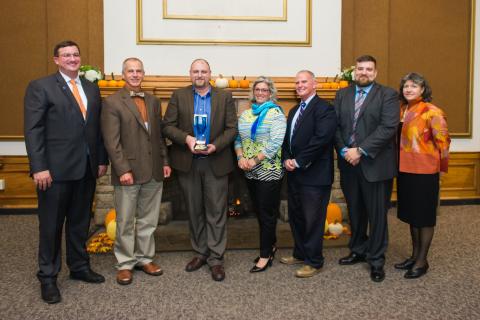
The Creation of UNHCEMS
UNH creates an online system for the inventory and use management of chemical stock, biological agents, radioactive materials, and hazardous waste. This system is known as UNHCEMS.
This innovation started with a fine from the EPA in 1997 due to violations of the Resource Conservation and Recovery Act. From this, innovators took the opportunity to thoughtfully design, develop, and implement an online inventory management system.
This is a remarkable 20-year collaboration between two departments within UNH’s Office of Research. Under the leadership of Brad Manning (EH&S) and Patrick Messer (RCC), we have seen EH&S at the forefront, mapping out the needs, vision, and use of the system, with RCC on the backend, developing the architecture and code.
Brad and Patrick’s leadership created the space for a fluid relationship to develop between those individuals who are truly responsible for making CEMS the resiliently dynamic system that it is.
This is a story about two entities that forged an innovative partnership to provide an enterprise-level solution that benefits the students, staff, faculty, and institution.
The Implementation and Success of UNHCEMS
Since UNHCEMS was first piloted in 2001 at UNH, the following has happened:
- Central processing and barcoding of every chemical on campus
- Decreased duplication of chemical purchases by virtue of chemical users able to see what chemicals are already on campus
- Reduced chemical waste and removal of outdated or excess chemicals
- Creation of door placards that clearly identifies the hazards within any given room
- Compliance with relevant legislation
- Delivery and tracking of annual training for use and care of those materials
Collectively, this translates into the improved integration of emergency services within a community, cost savings, managed risk, and a strong foundation for the growing and competitive research enterprise.
Early recognition from the EPA for CEMS led to licensing the system to Brown University in 2003, followed by an additional 30 academic and commercial licenses over the past 13 years. CEMS has generated over $1M in cumulative royalties, and provided an affordable solution for organizations to manage their hazardous material inventories, remain compliant with ever-changing, increasingly stringent federal requirements, and serve as a cornerstone for the prioritization of a culture of laboratory safety for any organization.
2015 Innovator of the Year
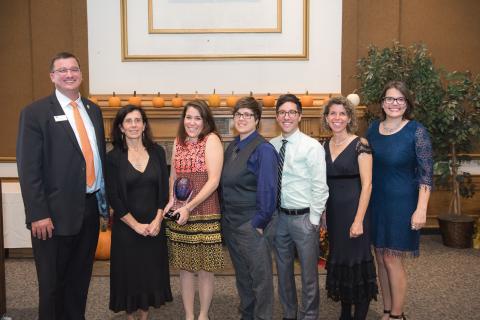
Prevention Innovations Research Center Background
The Prevention Innovations Research Center is full of extremely talented Innovators, led by Co-Founders, Jane Stapleton and Sharyn Potter.
Jane joined UNH in 1986 as an affiliate instructor in women’s studies. As an activist, administrator, policy maker, service provider, and researcher, she has worked in the field of ending sexual and relationship violence for 28 years.
Sharyn joined UNH in 1998 as an associate professor in the Department of Sociology. For the past 25 years she has been involved in sexual violence prevention as a lead researcher, sat on boards for rape crisis centers, and continues to be a vocal advocate for prevention methods.
In 2006, Prevention Innovations was formed as a research and training unit with a mission to develop, implement, and evaluate programs, policies, and practices to end sexual, relationship, and domestic violence. Since its inception, the leadership team has continued to participate in national and international research projects to meet its mission.
In January of 2015, through an internal grant initiative directed by Senior Vice Provost for Research, Jan Nisbet, Prevention Innovations became Prevention Innovations Research Center.
Since 2008, UNHInnovation has worked with Prevention Innovations. In 2011, UNHInnovation focused on the “Bringing in the Bystander” and “Know Your Power” programs and filed for federal trademark registration. Both of these programs are not only innovative, but are also the only evidence-based programs of their kind.
The Success of Their Innovations
The Center has produced a mobile app, video game, high school program and a private school program. In addition, they have been focusing their efforts on partnering with large state school higher education systems, extending its reach through international licensing, and even building a national consortium.
- In FY15 alone, Bringing in the Bystander has been non-exclusively licensed 106 times, representing 28.5% of FY15 licenses, creating $111,000 in licensing revenue;
- The Center has brought in nearly $4Million in external research funding;
- Added six employees;
- Became the lead researcher on a study conducted by the White House Task Force to Protect Students from Sexual Assault;
- Won the 2015 W.K. Kellogg Foundation Community Engagement Scholarship Award and was presented in the regional finals for the 2015 C. Peter Magrath Community Engagement Scholarship Award; AND,
- Undoubtedly, the most significant achievement, they are truly changing the world.
2014 Innovator of the Year
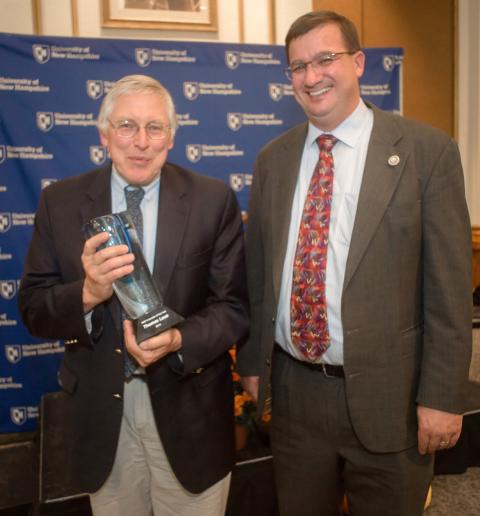
2013 Innovator of the Year
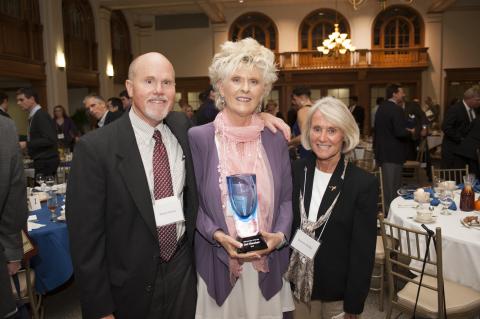
2012 Innovator of the Year
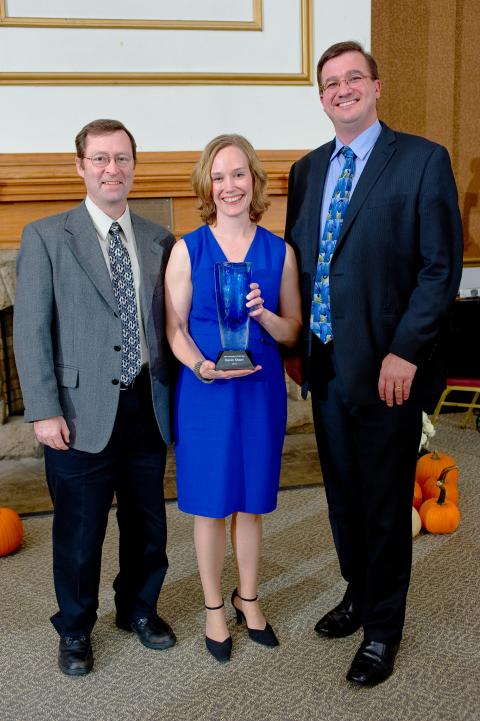
2011 Innovator of the Year
